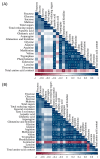Sugar and Free Amino Acid Contents in Winter Wheat Flour Under Fusarium Head Blight Treatment and Natural Infection
- PMID: 40431069
- PMCID: PMC12114655
- DOI: 10.3390/plants14101504
Sugar and Free Amino Acid Contents in Winter Wheat Flour Under Fusarium Head Blight Treatment and Natural Infection
Abstract
Fusarium head blight (FHB) is one of the most devastating diseases in wheat. Besides its negative impact on grain yield, FHB also negatively influences quality. Changes in sugar and free amino acid content were analyzed in flour from Fusarium-infected and non-infected grains of six wheat varieties differing in Fusarium resistance. The concentrations of sugars and free amino acids were determined using a high-performance liquid chromatography device. In flour from FHB-infected grains, the average total amount of fructose, glucose, maltose, total sugars, and total reducing sugars was significantly increased, compared to non-treated flour from the Tika Taka variety, which was the most FHB-susceptible. The total content of free amino acids in flour from FHB-infected varieties increased in proportion to their susceptibility. In Tika Taka, there was a significant increase in free amino acid content of about 46%, while a significant decrease of 16% was observed in the highly resistant Vulkan variety. A highly significant correlation was established between the degree of FHB susceptibility and the content of aspartic acid, glutamic acid, glutamine and histidine, glycine, alanine, methionine, valine, tryptophan, phenylalanine, leucine, and threonine. Most amino acids had strong positive correlations with each other, but among the sugars, only fructose and glucose content showed a strong positive correlation with specific amino acids that were induced by Fusarium infection. Overall, it can be concluded that FHB-susceptible varieties have a high risk of FHB infection, which results in the hydrolysis of sucrose into fructose and glucose, together with an increase in free amino acids, which deteriorates the quality of wheat.
Keywords: Fusarium; free amino acids; sugars; wheat.
Conflict of interest statement
The authors declare no conflicts of interest.
Figures








Similar articles
-
Changes in Antioxidant System during Grain Development of Wheat (Triticum aestivum L.) and Relationship with Protein Composition under FHB Stress.Pathogens. 2019 Dec 23;9(1):17. doi: 10.3390/pathogens9010017. Pathogens. 2019. PMID: 31878029 Free PMC article.
-
Early response of wheat antioxidant system with special reference to Fusarium head blight stress.Plant Physiol Biochem. 2017 Jun;115:34-43. doi: 10.1016/j.plaphy.2017.03.010. Epub 2017 Mar 14. Plant Physiol Biochem. 2017. PMID: 28319793
-
Metabolic Profiling Identifies Changes in the Winter Wheat Grains Following Fusarium Treatment at Two Locations in Croatia.Plants (Basel). 2023 Feb 17;12(4):911. doi: 10.3390/plants12040911. Plants (Basel). 2023. PMID: 36840259 Free PMC article.
-
Fusarium Head Blight in Durum Wheat: Recent Status, Breeding Directions, and Future Research Prospects.Phytopathology. 2019 Oct;109(10):1664-1675. doi: 10.1094/PHYTO-03-19-0095-RVW. Epub 2019 Sep 3. Phytopathology. 2019. PMID: 31369363 Review.
-
Exploring and applying genes to enhance the resistance to Fusarium head blight in wheat.Front Plant Sci. 2022 Oct 27;13:1026611. doi: 10.3389/fpls.2022.1026611. eCollection 2022. Front Plant Sci. 2022. PMID: 36388594 Free PMC article. Review.
References
-
- Leonard K.J., Bushnell W.R. Fusarium Head Blight of Wheat and Barley. APS Press; St. Paul, MN, USA: 2003. p. 512.
-
- Somma S., Petruzzella A.M., Logrieco A.F., Meca G., Cacciola S.O., Moretti A. Phylogenetic analysis of Fusarium graminearum strains from cereals in Italy, and characterisation of their molecular and chemical chemotypes. Crop Pature Sci. 2014;65:52–60. doi: 10.1071/CP13314. - DOI
-
- Beccari G., Prodi A., Senatore M.T., Balmas V., Tini F., Onofri A., Pedini L., Sulyok M., Brocca L., Covarelli L. Cultivation area affects the presence of fungal communities and secondary metabolites in Italian durum wheat grains. Toxins. 2020;12:97. doi: 10.3390/toxins12020097. - DOI - PMC - PubMed
-
- Pancaldi D., Tonti S., Prodi A., Salomoni D., Dal Prà M., Nipoti P., Alberti I., Pisi A. Survey of the main causal agents of Fusarium head blight of durum wheat around Bologna, northern Italy. Phytopathol. Mediterr. 2010;49:258–266.
Grants and funding
LinkOut - more resources
Full Text Sources

